Tomato sauce
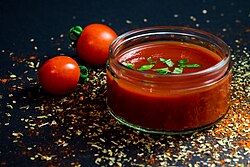 Fresh tomato sauce | |
| Alternative names | Salsa Roja |
|---|---|
| Type | Sauce |
| Place of origin | Mexico[1] |
| Region or state | Aztec Empire |
| Main ingredients | Tomatoes |
| Variations | Salsa picante, Arrabbiata sauce |
Tomato sauce (also known as Neapolitan sauce, salsa roja in Spanish, or salsa di pomodoro in Italian) can refer to many different sauces made primarily from tomatoes, usually to be served as part of a dish, rather than as a condiment. Tomato sauces are common for meat and vegetables, but they are perhaps best known as bases for Mexican salsas or sauces for pasta dishes. Tomatoes have a rich flavor, high water content, soft flesh which breaks down easily, and the right composition to thicken into a sauce when they are cooked (without the need of thickeners such as roux). All of these qualities make them ideal for simple and appealing sauces.
In countries such as the United Kingdom, India, Australia, New Zealand, and South Africa, the term tomato sauce is used to describe a condiment similar to ketchup.[2] In some of these countries, both terms are used for the condiment.
History[]
The first person to write about what may have been a tomato sauce was Bernardino de Sahagún, a Franciscan friar from the Kingdom of Spain who later moved to New Spain, mentioned a prepared sauce that was offered for sale in the markets of Tenochtitlan (Mexico City today).[3] The first Italian cookbook to include tomato sauce, Lo Scalco alla Moderna ('The Modern Steward'), was written by Italian chef Antonio Latini and was published in two volumes in 1692 and 1694. The use of tomato sauce with pasta appeared for the first time in 1790 in the Italian cookbook L'Apicio moderno, by Roman chef Francesco Leonardi.[4]
Description[]
This section does not cite any sources. (January 2021) |
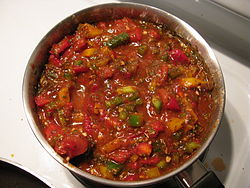
The simplest tomato sauce consists just of chopped tomatoes cooked down (possibly with olive oil) and simmered until it loses its raw flavor. Of course, it may be seasoned with salt, or other herbs or spices. Optionally, tomato skins may be scalded and peeled according to texture (especially thicker pelati paste varieties) and tomato seeds may be removed for aesthetic purposes, leaving just the tomato flesh and pulp.
Just like tomato puree or tomato paste, tomato sauce may be one of the ingredients in other dishes, like a tomato-based soup. The sauce is thinner than either the puree, or the paste (which is the thickest), and it may have additional flavors.
Water (or a more flavorful liquid, such as stock or wine) is sometimes added to keep it from drying out too much. Onion and garlic are almost always sweated or sautéed at the beginning before the tomato is added, or puréed together with tomatoes and then cooked together. Other seasonings typically include dried mild chili peppers (such as guajillo chili or pasilla chili), epazote, basil, oregano, parsley, and black pepper. Ground or chopped meat is also common.
Varieties[]
Mexican[]

Tomato sauce was an ancient condiment in Mesoamerican food. The first person to write about what may have been a tomato sauce was Bernardino de Sahagún, a Franciscan friar from the Kingdom of Spain who later moved to New Spain, made note of a prepared sauce that was offered for sale in the markets of Tenochtitlan (Mexico City today). Of this he wrote (translated from Spanish),
They sell some stews made of peppers and tomatoes – usually put in them peppers, pumpkin seeds, tomatoes, green peppers and fat tomatoes and other things that make tasty stews.[3]
— Florentine Codex (1540–1585)
Spaniards later brought the use of tomatoes to Europe.
Basic Mexican tomato sauce (salsa de tomate rojo o jitomate) was traditionally prepared with a molcajete to puree the tomatoes. Food that is cooked in tomato sauce is known as entomatada. Tomato sauce is used as a base for spicy sauces and moles.[5]
Italian[]
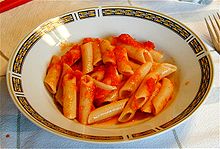
The misconception that the tomato has been central to Italian cuisine since its introduction from the Americas is often repeated. Though the tomato was introduced from the Spanish New World to European botanists in the 16th century, tomato sauce made a relatively late entry in Italian cuisine: in Antonio Latini's cookbook Lo scalco alla moderna (Naples, 1692).[6]
Latini was chef to the Spanish viceroy of Naples, and one of his tomato recipes is for sauce alla spagnuola, "in the Spanish style". The first known use of tomato sauce with pasta appears in the Italian cookbook L'Apicio moderno, by Roman chef Francesco Leonardi, edited in 1790.[4]
Italian varieties of tomato sauce range from the very simple pasta al pomodoro to the piquant puttanesca and arrabbiata sauces. Tomato sauce with pasta can stand on its own or it can also be paired with ingredients such as sausage, clams, pancetta cubes, tuna or vegetables, for a more lively pasta dish.[citation needed]
Tomato-garlic sauce is prepared using tomatoes as a main ingredient, and is used in various cuisines and dishes. In Italian cuisine, alla pizzaiola refers to tomato-garlic sauce, which is used on pizza, pasta and meats.[7]
French[]
Sauce tomate is one of the five mother sauces of classical French cooking, as codified by Auguste Escoffier in the early 20th century. It consists of salt belly of pork, onions, bay leaves, thyme, tomato purée or fresh tomatoes, roux, garlic, salt, sugar, and pepper.[citation needed]
New Zealand and South Africa[]
The most common use of the term tomato sauce in New Zealand and South Africa is to describe a popular, commercially produced condiment that is a type of table sauce, similar to American ketchup but without vinegar, which is typically applied to foods such as meat pies, sausages, other cooked meat (in particular steak), and fish and chips.[8] Tomato-based sauces served with pasta would commonly be referred to as "pasta sauce" or "Napoletana sauce".[disputed ]
United Kingdom[]
The meaning of the term "tomato sauce" depends on the context; on a restaurant menu the phrase "in a tomato sauce" means a freshly prepared tomato based sauce as used on pasta, and colloquially it may refer to either the pasta sauce, or tomato ketchup.[disputed ]
Australia[]
In Australia "tomato sauce" generally refers to the same style of table sauce as American ketchup but varies in mixture and does not contain onions.[9] Some sources say that Australian tomato sauce has less tomato than ketchup,[10] but this varies between brands and is not a universal feature. Australian tomato sauce is used in the same way as American ketchup. "Tomato sauce" may also be used in its generic English meaning of a sauce primarily based on tomatoes, as in a menu item "Gnocchi in a tomato sauce" where it would be understood that the sauce would be of the kind used in Italian cooking for pastas.[citation needed]
United States[]
This section needs additional citations for verification. (January 2021) |


In the U.S., "tomato sauce" refers to two distinct sauces. One is a tomato concentrate with salt and minimal herbs, used in cooking. This product is considered incomplete and not normally used as is. Related ingredients are tomato purée and tomato paste, each of which is similar but paste has a thicker consistency. Tomato purée and tomato paste have FDA standards of identity (since 1939) for percentage of tomato solids, and historically did not contain seasonings other than salt; in recent decades variants with basil or other traditional Italian seasonings became common. Tomato sauce is nonstandardized.[11]
The second use of the term "tomato sauce" in the U.S. is for a cooked sauce of tomatoes, usually containing olive oil and garlic. This type of tomato sauce is generally served with pasta, and sometimes with meat. Less commonly, it is served with chicken or beef alone. One popular variety of tomato sauce is marinara sauce, an Italian-American term for a simple tomato sauce with herbs – mostly basil and oregano.
Contrary to what the name might suggest (marinara is Italian for 'sailor-style') it is without seafood. In Italy, marinara refers either to sauces made with tomato and garlic (as in pizza marinara) or to seafood-based sauces or foods; in this case, the name does not imply that tomato is either included or excluded.
Some Italian Americans on the East Coast and around the Chicago area refer to tomato sauce as "gravy", "tomato gravy", or "Sunday gravy", especially sauces with a large quantity of meat simmered in them, similar to the Italian Neapolitan ragù. The term "Sunday gravy" derives from the Italian tradition of having a large, family dinner on Sunday afternoons. "Gravy" is an erroneous English translation from the Italian sugo which means juice, but can also mean sauce (as in sugo per pastasciutta).[12]
The expression for "gravy" in Italian is sugo d'arrosto, which is literally "juice of a roast" and is not specifically tomato sauce.[12] Sicilian Americans in communities like Buffalo and Rochester, New York, use the terms "sarsa" and "succu" interchangeably for tomato sauces of all types used with pasta, and "gravy" only in reference to brown meat gravies. The Italian-American community of New Orleans, however, is largely Sicilian in origin and takes great pride in its Creole-Italian cuisine largely based on what is known locally as "red gravy" (tomato sauce).
American supermarkets commonly carry a variety of prepared tomato sauces described as "spaghetti sauce" or "pasta sauce". Common variations include meat sauce, marinara sauce, and sauces with mushrooms or sweet red peppers.
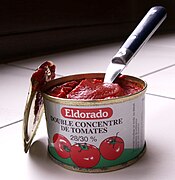
A can of tomato paste
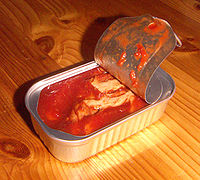
Tinned mackerel fillet in tomato sauce is a popular food in Scandinavia
Louisiana[]
A spicy tomato sauce known as sauce piquante is common in Louisiana Cajun cuisine, that can contain any seafood, poultry, or meats such as wild game. It is typically served over white rice. In Louisiana Creole cuisine, there is a tomato sauce known as a Creole sauce. It is similar to Italian tomato sauce, but features more Louisiana flavors derived from the fusion of French and Spanish cooking styles. They both usually contain the traditional holy trinity of diced bell pepper, onion, and celery.
Tomato gravy[]
Tomato gravy is distinct from the term as used by Italian Americans when referring to a type of tomato sauce particularly where tomatoes were a staple food.[citation needed] The cooked tomatoes, some fat (usually cured pork fat) and flour are cooked together until thick, and seasoned with salt and pepper. Onions or bell peppers may be added as well. Typically, tomato gravy is served over pasta.
Indian[]
Some Indian curries have a tomato based sauce, notably many vegetarian style dishes.[citation needed]
See also[]
References[]
- ^ "Mexico's Early Cookbooks". oxfordre.com.
- ^ "traditional aussie meat pie with tomato sauce, Perth, Australia". Journals.worldnomads.com. Retrieved 2010-11-17.
- ^ Jump up to: a b "Historia del tomate – Historia de la Cocina y la Gastronomía". www.historiacocina.com (in Spanish).
- ^ Jump up to: a b L'Arte della cucina in Italia, Emilio Faccioli, Einaudi, Milano, 1987
- ^ "Traditional Mexican cuisine – ancestral, ongoing community culture, the Michoacán paradigm – intangible heritage". www.unesco.org. Culture Sector – UNESCO. Retrieved 2017-03-23.
- ^ Elizabeth David, Italian Food (1954, 1999), p. 319, and John Dickie, Delizia! The Epic History of the Italians and Their Food, 2008, p. 162.
- ^ Anderson, B. (2001). The Foods of Italy: The Quality of Life. Naturalmente Italiano. Italian Trade Commission. p. 154. Retrieved July 29, 2017.
- ^ "Tucker". Australianbeers.com. Retrieved 2010-11-17.
- ^ "Heinz Ketchup (US)"."Heinz Ketchup (AU)".
- ^ "What's the difference between tomato sauce and ketchup?". news.com.au. Retrieved 2 April 2018.
- ^ "Contadina – Tips & Advice – Contadina FAQs". Contadina.com. Retrieved 2010-11-17.
- ^ Jump up to: a b Love, C., Webster's New World Italian Dictionary, Concise Edition (Macmillan 1991) ISBN 0-13-953639-6
External links[]
| Wikibooks Cookbook has a recipe/module on |
- The Cook's Decameron: A Study In Taste, Containing Over Two Hundred Recipes For Italian Dishes from Project Gutenberg. This is from a very old source, and reflects the cooking at the turn of the 20th century.
- Classic, authentic Italian "Sunday Gravy"
- Italian sauces
- Mother sauces
- Tomato products
- Tomato sauces


